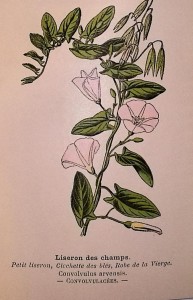This post is part of an ongoing series featuring items recently cataloged from the Julio Mario Santo Domingo Collection.
 Liseron des champs also known as field bindweed or the “Virgin’s dress” comes from the morning glory family. A climbing or creeping plant it can also grow up to 2 meters high. Though the trumpet shaped flowers are physically pleasing to the eye it is known as a nuisance weed that chokes out cultivated plants. This invasive plant can be difficult to get rid of because the seeds remain viable for up to twenty years in the soil and one single plant can produce a whopping 500 seeds.
Liseron des champs also known as field bindweed or the “Virgin’s dress” comes from the morning glory family. A climbing or creeping plant it can also grow up to 2 meters high. Though the trumpet shaped flowers are physically pleasing to the eye it is known as a nuisance weed that chokes out cultivated plants. This invasive plant can be difficult to get rid of because the seeds remain viable for up to twenty years in the soil and one single plant can produce a whopping 500 seeds.
Red valerian has a number of different names such as kiss-me-quick, fox’s brush and my personal favorite- Jupiter’s beard! It can be found in rocky locations at low elevations with a high alkaline content in the soil. Both the leaves and roots can be eaten, in salads or soups, but whether they are actually tasty seems to be in question. Although red valerian is sometimes reported to have medicinal properties it is probably due to a confusion with true valerian or Valeriana officinalis. This type of valerian has been used as a sedative, migraine treatment, pain reliever, and antiseptic. But most fascinating is the use of valerian in medieval Sweden where it was put in a groom’s wedding clothing to ward off the “envy of elves.”
Atlas de poche des plantes des champs, des prairies et des bois : a l’usage des promeneurs et des excursionistes. Série 1 / par R. Siélain. 3e Édition. Paris : Paul Klincksieck, 1895. FL 40 Si52a Series 1 1896
Atlas de poche des plantes des champs, des prairies et des bois : a l’usage des promeneurs et des excursionnistes. Série 2 / par R. Siélain. Paris : P. Klincksieck, 1896. FL 40 Si52a Series 2 1896.
Both of these series can be found at the Botany Libraries.
Thanks to Alison Harris, Santo Domingo Project Manager, Gretchen Wade, Judith Warnement, and Chris Robson, Cataloger from the Botany Libraries for contributing this post.



